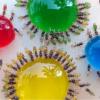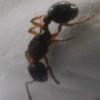Well, I don't see a need.
One day in the future, beyond our lives...Earth will eventually become hotter and probably more tropical like it has before. Then of course, it will go back to being cold into an ice age like it has before.
But, once Earth warms up enough...even the United Kingdom will become much warmer. If I recall, it has been really warm in the past. Even Greenland has been a tropical place at one point. I don't imagine every ant will drop dead on the continent because it will be too warm for them to hibernate. It has happened before, and there are still lots of ants around.
Of course, that will be a "short" amount of Earth years...but, too many years from now for us. 
In any case, I've seen both Camponotus and Pogonomyrmex and other natives, disappear in some areas...but, remain active year round in other places. Like, when I went to the mountains in San Diego...I saw Camponotus roaming around in December because it was a hot week that month (well, the entire Winter). I went back a week later, and they were still active. Then, during the Summer storms, the same colony was sending out alates. I'm pretty sure they didn't even hibernate, was pretty hot that year for us. In fact, San Diego didn't even see Winter in 2013 and it was pretty hot and dry the whole season. With that...funny enough, even though mountain ants tend to hibernate more...they were active that whole season. But, all the local coastal native ants had disappeared.
Then again, maybe the more Northernly ants die off if they don't hibernate compared to the more southern ones. Seems kind of a huge weakness in regards to climate change. I wouldn't want to be reborn as one of those ants since Earth is having a warming trend. 


















